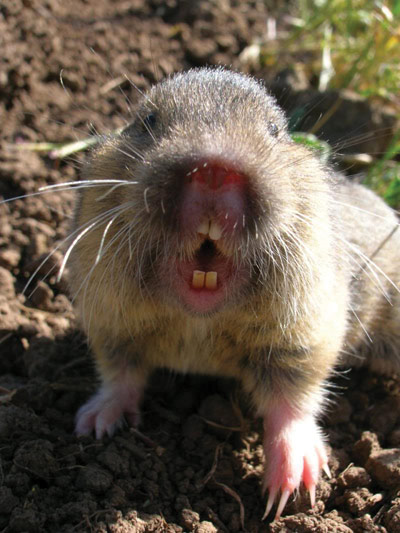Tending to Your Garden
Fall Planting and Gopher Eradication
GOPHERS BE GONE: Gophers, more accurately known as pocket gophers, do the most damage of any animal in our gardens. For the best eradication, box-type traps are the most successful. But these are smart little devils, and you need to camouflage the traps and bait them just so if you want to catch them. Find their main run and excavate a hole large enough to insert the trap flush against the opening into the tunnel. In fact, make it big enough for two traps; you’ll double your chances of catching the gopher if you place them back to back facing both directions of the run. Always handle the traps with gloves on so that your scent doesn’t give you away.

Put a drop of anise oil (available at your local supermarket in the spice aisle) on the back wall of the trap, and add a nice fresh sprig of cheeseweed (Malva, one of your gopher’s favorite weeds) to camouflage the trigger mechanism. This little salad will be irresistible to even the wiliest gopher. Cover the traps and run so that no light can shine in and foil your plan. Flag your site with a stake so you can find it again, and come back in a few hours to check the trap. If the gopher has managed to steal the bait, redo the whole thing again.
You can reset the trap in the same run even if you caught one, as several gophers may use the same tunnels. New gophers may move into old runs, too, after the first inhabitants have gone. Be persistent and you should be able to reduce the damage.
The best protection, of course, is a chicken wire cage installed around the roots of your plants when you plant. The chicken wire will last for years and stop those burrowing beasts in their tracks. Be sure to let the cage extend above ground a couple of inches, though, as gophers and moles may just surface when they hit an obstacle and then dive in again on the other side. For larger-scale plantings, build raised beds, and line them with heavy-duty aviary netting, foiling them on all fronts for good.
FALL PLANTING TIPS: The mantra of fall gardening is (repeat after me): Fall is for planting. This is the best season to get perennial plants, shrubs, and trees established. Drought-tolerant plants (the best kind for the Mediterranean climate zone of Southern California) will grow sturdy root systems while the soil is still warm, even make some growth in the warmer days of winter between rains, and then be poised to push new topside growth as soon as spring weather arrives.
Among the best candidates for such plantings are many California natives. For a great selection, visit the Santa Barbara Botanic Garden’s annual Fall Sale (opening day is Sat., Oct. 2). There are not only many great plants to choose from but also volunteers and staff who can give great advice for selection, planting, and maintenance.
Speaking of natives, it is time to cut back some of the established ones. Matilija poppies can be cut clear to the ground. Others that are slowing down for a semi-dormant period are monkeyflowers, sages, and goldenrods. The appearance of all of these will be the cue to trim and lightly prune. Ratty-looking foliage and a pause in the bloom season is an indication of their ebbing vitality. Some of the shrubby species will drop many of their leaves as an indication that they are slowing down. If there isn’t time right now, very early spring will be just as appropriate.
There are many perennials that can benefit from dividing now. These include the semi-bulbous ones like agapanthus, clivia, and daylilies, as well as those with a more fibrous crown like Shasta daisies, Coreopsis grandiflora selections, and penstemons. Dig up the whole clump with an ample rootball, and separate into two, three, or even four smaller clumps that still contain a good root system. Cut the foliage down by at least one third to reduce the stress from respiration (in which the plant loses water as part of the photosynthetic process). Replant immediately, sharing the surplus with neighbors and friends.
It’s always a good idea to sterilize saws, shears, and pruners between jobs and even between plants that may be very susceptible to infection (palms!). Consider treating your plant stakes and supports, too, especially if they are wood or another porous material. Make a dilute bleach solution with one part bleach to 10 parts water, and give them a good brush or soak. This is also an excellent treatment to clean up used terra cotta pots. Brush off excess soil mix and mineral buildup and then bathe them in the bleach water.
It’s fall: a whole new growing season. Enjoy!



